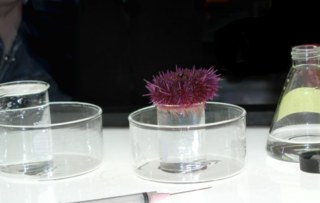Related Research Articles

Toxicity is the degree to which a chemical substance or a particular mixture of substances can damage an organism. Toxicity can refer to the effect on a whole organism, such as an animal, bacterium, or plant, as well as the effect on a substructure of the organism, such as a cell (cytotoxicity) or an organ such as the liver (hepatotoxicity). Sometimes the word is more or less synonymous with poisoning in everyday usage.

A safety data sheet (SDS), material safety data sheet (MSDS), or product safety data sheet (PSDS) is a document that lists information relating to occupational safety and health for the use of various substances and products. SDSs are a widely used type of fact sheet used to catalogue information on chemical species including chemical compounds and chemical mixtures. SDS information may include instructions for the safe use and potential hazards associated with a particular material or product, along with spill-handling procedures. The older MSDS formats could vary from source to source within a country depending on national requirements; however, the newer SDS format is internationally standardized.

Aquatic toxicology is the study of the effects of manufactured chemicals and other anthropogenic and natural materials and activities on aquatic organisms at various levels of organization, from subcellular through individual organisms to communities and ecosystems. Aquatic toxicology is a multidisciplinary field which integrates toxicology, aquatic ecology and aquatic chemistry.

The Toxic Substances Control Act (TSCA) is a United States law, passed by the 94th United States Congress in 1976 and administered by the United States Environmental Protection Agency (EPA), that regulates chemicals not regulated by other U.S. federal statutes, including chemicals already in commerce and the introduction of new chemicals. When the TSCA was put into place, all existing chemicals were considered to be safe for use and subsequently grandfathered in. Its three main objectives are to assess and regulate new commercial chemicals before they enter the market, to regulate chemicals already existing in 1976 that posed an "unreasonable risk of injury to health or the environment", as for example PCBs, lead, mercury and radon, and to regulate these chemicals' distribution and use.

The Emergency Planning and Community Right-to-Know Act of 1986 is a United States federal law passed by the 99th United States Congress located at Title 42, Chapter 116 of the U.S. Code, concerned with emergency response preparedness.

Fluoranthene is a polycyclic aromatic hydrocarbon (PAH). The molecule can be viewed as the fusion of naphthalene and benzene unit connected by a five-membered ring. The chemical formula is C16H10. Although samples are often pale yellow, the compound is colorless. It is soluble in nonpolar organic solvents. It is a member of the class of PAHs known as non-alternant PAHs because it has rings other than those with six carbon atoms. It is a structural isomer of the alternant PAH pyrene. It is not as thermodynamically stable as pyrene. Its name is derived from its fluorescence under UV light.

The Globally Harmonized System of Classification and Labelling of Chemicals (GHS) is an internationally agreed-upon standard managed by the United Nations that was set up to replace the assortment of hazardous material classification and labelling schemes previously used around the world. Core elements of the GHS include standardized hazard testing criteria, universal warning pictograms, and safety data sheets which provide users of dangerous goods relevant information with consistent organization. The system acts as a complement to the UN numbered system of regulated hazardous material transport. Implementation is managed through the UN Secretariat. Although adoption has taken time, as of 2017, the system has been enacted to significant extents in most major countries of the world. This includes the European Union, which has implemented the United Nations' GHS into EU law as the CLP Regulation, and United States Occupational Safety and Health Administration standards.
The European Chemicals Bureau (ECB) was the focal point for the data and assessment procedure on dangerous chemicals within the European Union (EU). The ECB was located in Ispra, Italy, within the Joint Research Centre (JRC) of the European Commission. In 2008 the ECB completed its mandate. Some of its activities were taken over by the European Chemicals Agency (ECHA); others remained within the Joint Research Centre. The history of the ECB has been published as a JRC technical report.
The regulation of chemicals is the legislative intent of a variety of national laws or international initiatives such as agreements, strategies or conventions. These international initiatives define the policy of further regulations to be implemented locally as well as exposure or emission limits. Often, regulatory agencies oversee the enforcement of these laws.
A substance of very high concern (SVHC) is a chemical substance which has been proposed as a candidate for inclusion on the Authorization or Restriction list of REACH. The addition of a substance to the SVHC Candidate List by the European Chemicals Agency (ECHA) is the first step in the procedure for the authorisation or restriction of a chemical. It is expected that industries operating in EU member states abide by the regulations of REACH and submit chemicals for consideration when appropriate.

The Office of Environmental Health Hazard Assessment, commonly referred to as OEHHA, is a specialized department within the cabinet-level California Environmental Protection Agency (CalEPA) with responsibility for evaluating health risks from environmental chemical contaminants.
A Chemical safety assessment (CSA) is an analysis used in many situations where chemical are used and where there is a possibility that they may present a risk to life, health or the environment.

Galaxolide is a synthetic musk with a clean sweet musky floral woody odor used in fragrances. It is one of the musk components that perfume and cologne manufacturers use to add a musk odor to their products. Galaxolide was first synthesized in 1956, and used in the late 1960s in some fabric softeners and detergents. High concentrations were also incorporated in fine fragrances.
In aquatic toxicology, bioconcentration is the accumulation of a water-borne chemical substance in an organism exposed to the water.
Persistent, bioaccumulative and toxic substances (PBTs) are a class of compounds that have high resistance to degradation from abiotic and biotic factors, high mobility in the environment and high toxicity. Because of these factors PBTs have been observed to have a high order of bioaccumulation and biomagnification, very long retention times in various media, and widespread distribution across the globe. Most PBTs in the environment are either created through industry or are unintentional byproducts.
Toxicodynamics, termed pharmacodynamics in pharmacology, describes the dynamic interactions of a toxicant with a biological target and its biological effects. A biological target, also known as the site of action, can be binding proteins, ion channels, DNA, or a variety of other receptors. When a toxicant enters an organism, it can interact with these receptors and produce structural or functional alterations. The mechanism of action of the toxicant, as determined by a toxicant’s chemical properties, will determine what receptors are targeted and the overall toxic effect at the cellular level and organismal level.
Occupational toxicology is the application of toxicology to chemical hazards in the workplace. It focuses on substances and conditions that people may be exposed to in workplaces, including inhalation and dermal exposures, which are most prevalent when discussing occupational toxicology. These environmental and individual exposures can impact health, and there is a focus on identifying early adverse affects that are more subtle than those presented in clinical medicine.
Toxicological databases are large compilations of data derived from aquatic and environmental toxicity studies. Data is aggregated from a large number of individual studies in which toxic effects upon aquatic and terrestrial organisms have been determined for different chemicals. These databases are then used by toxicologists, chemists, regulatory agencies and scientists to investigate and predict the likelihood that an organic or inorganic chemical will cause an adverse effect on exposed organisms.
The GreenScreen List Translator is a procedure for assessing chemical hazard used to identify chemicals of concern to prioritize for removal from product formulations. The List Translator assesses substances based on their presence on lists of chemicals associated with human and environmental health hazards issued by a global set of governmental and professional scientific bodies, such as the European Union’s GHS hazard statements and California's Proposition 65.

Bis(2-ethylhexyl)tetrabromophthalate (or TBPH), is a brominated phthalate derivative with the formula C24H34Br4O4 commonly used as a brominated flame retardant (BFR).
References
- ↑ Heine, Lauren; Franjevic, Shari (January 2013). "Chemical Hazard Assessment and the GreenScreen for Safer Chemicals". Issues in Environmental Science and Technology. 36. doi:10.1039/9781849737234-00129 . Retrieved 6 June 2018.
- ↑ GreenScreen for Safer Chemicals Hazard Assessment Guidance for Chemicals, Polymers and Products (Version 1.4 ed.). Clean Production Action. January 2018. Retrieved 17 January 2018.
- ↑ Holder, Helen A.; Mazurkiewicz, P. H.; Robertson, C. A.; Wray, C. A. (2013). "Hewlett-Packard's use of the GreenScreen for safer chemicals". In R. M. Harrison; R. E. Hester (eds.). Chemical alternatives assessments. Issues in Environmental Science and Technology. Cambridge: Royal Society of Chemistry. pp. 157–176. ISBN 978-1-84973-723-4.
- ↑ Winnebeck, Kathryn (March 2011). "An abbreviated alternatives assessment process for product designers: a children's furniture manufacturing case study". Journal of Cleaner Production. 19 (5): 464–476. Bibcode:2011JCPro..19..464W. doi:10.1016/j.jclepro.2010.10.008.
- ↑ Rob Guzzo, Mike Werner, Art Fong, Lida Tan, Thomas Ebert (September 2016). “Integrating Toxicological Assessments in Material Selection for Apple Products”. Apple. Retrieved October 2018.
- ↑ "HPD Open Standard". HPDC. Health Product Declaration Collaborative. Retrieved 6 June 2018.
- ↑ "Help Center: How are products scored?". Portico. Healthy Building Network. Retrieved 3 October 2018.
- ↑ "Building product disclosure and optimization - material ingredients". EED BD+C: New Construction v4 - LEED v4 - Materials & Resources. US Green Building Council. Retrieved 6 June 2018.
- ↑ "Living Product Challenge Standard V 1.1" (PDF). Living Product Challenge Certification. International Living Future Institute. Retrieved 6 June 2018.
- ↑ Heine, Lauren. "Material Health Evaluation Programs Harmonization Opportunities Report" (PDF). USGBC Resources. US Green Building Council. Retrieved 6 June 2018.